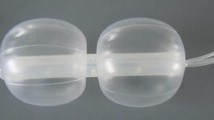Abstract
Background
This study aimed to evaluate the effect of two different sterilization protocols on the bacterial counts in the swine colon as preparation for natural orifice translumenal endoscopic surgery (NOTES) surgery.
Methods
In this study, 16 swine were randomized to two different colonic sterilization protocols: low colonic irrigation using 300 ml of a 1:1 dilution of 10% povidone–iodine (Betadine) with sterile saline, followed by 1 g of cefoxitin dissolved in 300 ml of saline or two consecutive 300-ml irrigations using a quaternary ammonium antimicrobial agent (Onamer M). Colonic cultures were taken before colonic cleansing after a decontamination protocol and after completion of the NOTES procedure. The Invitrogen live/dead bacterial viability kit was used to assess for change in the bacterial load. A qualitative culture of peritoneal fluid was obtained at the end of the NOTES procedure. Colon mucosal biopsies obtained immediately after the sterilization procedure and at the 2-week necropsy point were evaluated for mucosal changes.
Results
Protocol 1 resulted in an average 93% decrease in live colonic bacteria versus 90% with protocol 2 (nonsignificant difference). After a NOTES procedure, group 1 had a 62% increase in live bacteria and group 2 had a 31% increase (nonsignificant difference). Peritoneal cultures also were obtained. Bacteria were isolated from the peritoneal fluid of all the animals, and two or more species were isolated from 75% of the animals. There was no evidence of peritoneal infection at necropsy. Reactive epithelial changes and mild inflammation were the only pathologic abnormalities. No changes were noted at histologic evaluation of colonic mucosa after 2 weeks, demonstrating that these were temporary changes.
Conclusion
Colonic irrigation with Betadine and antibiotics are as effective for bacterial decontamination of the swine colon as a quaternary ammonium compound. The results of this study support the use of either protocol. Despite thorough decontamination, peritoneal contamination occurs. The significance of this for humans is unknown.
Similar content being viewed by others
References
Rattner D, Kalloo A (2006) ASGE/SAGES Working Group on natural orifice translumenal endoscopic surgery. Surg Endosc 20:329–333
Kalloo AN, Singh VK, Jagannath SB, Niiyama H, Hill SL, Vaughn CA, Magee CA, Kantsevoy SV (2004) Flexible transgastric peritoneoscopy: a novel approach to diagnostic and therapeutic interventions in the peritoneal cavity. Gastrointest Endosc 60:114–117
Espin-Basany E, Sanchez-Garcia JL, Lopez-Cano M, Lozoya-Trujillo R, Medarde-Ferrer M, Armadans-Gil L, Alemany-Vilches L, Armengol-Carrasco M (2005) Prospective, randomised study on antibiotic prophylaxis in colorectal surgery. Is it really necessary to use oral antibiotics? Int J Colorectal Dis 20:542–546
Sporn E, Bachman SL, Miedema BW, Loy TS, Calaluce R, Thaler K (2008) Endoscopic colotomy closure for natural orifice transluminal endoscopic surgery using a T-fastener prototype in comparison to conventional laparoscopic suture closure. Gastrointest Endosc 68:724–730
Guenaga K, Atallah AN, Castro AA, Matos DDM, Wille-Jorgensen P (2008) Mechanical bowel preparation for elective colorectal surgery. Cochrane Database of Systematic Reviews, John Wiley & Sons, Ltd.
Valverde A, Simon M, Reza K, Jean-Marie H, Anne-Cécile C, Yves F (2006) Povidone-iodine vs sodium hypochlorite enema for mechanical preparation before elective open colonic or rectal resection with primary anastamosis. Arch Surg 141:1168–1174, discussion 1175
Hay JM, Boussougant Y, Lacaine F, Régnard JF, Molkhou JM, Roverselli D (1989) Povidone-iodine enema as a pre-operative bowel preparation for colorectal surgery: a bacteriologic study. Dis Colon Rectum 32:9–13
Fingerhut A, Hay JM (1993) Single-dose ceftriaxone, ornidazole, and povidone-iodine enema in elective left colectomy. A randomized multicenter controlled trial. The French Association for Surgical Research. Arch Surg 128:228–232
Narula VK, Hazey JW, Renton DB, Reavis KM, Paul CM, Hinshaw KE, Needleman BJ, Mikami DJ, Ellison EC, Melvin WS (2008) Transgastric instrumentation and bacterial contamination of the peritoneal cavity. Surg Endosc 22:605–611
Fong DG, Pai RD, Thompson CC (2007) Transcolonic endoscopic abdominal exploration: a NOTES survival study in a porcine model. Gastrointest Endosc 65:312–318
Wilhelm D, Meining A, von Delius S, Fiolka A, Can S, Hann von Weyhern C, Schneider A, Feussner H (2007) An innovative, safe and sterile sigmoid access (ISSA) for NOTES. Endoscopy 39:401–406
Acknowledgments
This study was generously funded by a grant from Ethicon EndoSurgery. The authors thank Dr. Timothy Loy for pathology assistance and Ms. Kristine Toft for her invaluable assistance in the animal laboratory.
Author information
Authors and Affiliations
Corresponding author
Rights and permissions
About this article
Cite this article
Bachman, S.L., Sporn, E., Furrer, J.L. et al. Colonic sterilization for natural orifice translumenal endoscopic surgery (NOTES) procedures: a comparison of two decontamination protocols. Surg Endosc 23, 1854–1859 (2009). https://doi.org/10.1007/s00464-008-0295-0
Received:
Revised:
Accepted:
Published:
Issue Date:
DOI: https://doi.org/10.1007/s00464-008-0295-0




